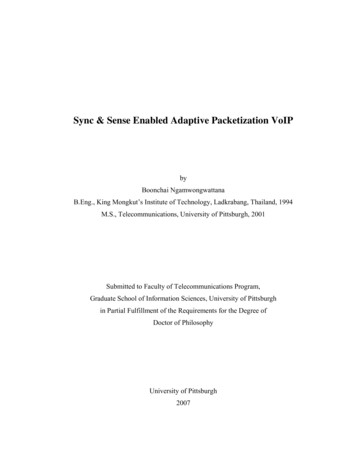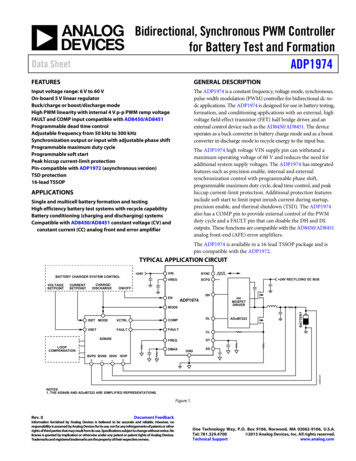
Transcription
Sync & Sense Enabled Adaptive Packetization VoIPbyBoonchai NgamwongwattanaB.Eng., King Mongkut’s Institute of Technology, Ladkrabang, Thailand, 1994M.S., Telecommunications, University of Pittsburgh, 2001Submitted to Faculty of Telecommunications Program,Graduate School of Information Sciences, University of Pittsburghin Partial Fulfillment of the Requirements for the Degree ofDoctor of PhilosophyUniversity of Pittsburgh2007
Copyright 2007 byBoonchai NgamwongwattanaAll rights reserved.ii
University of PittsburghSchool of Information SciencesDepartment of Information Sciences and TelecommunicationsThis dissertation was presentedbyBoonchai NgamwongwattanaIt was defended onApril 6, 2007and approved byDr. Richard Thompson (Advisor)Dr. David TipperDr. Martin WeissDr. Joseph KabaraDr. Stephen Waltersiii
Sync & Sense Enabled Adaptive Packetization VoIPBoonchai Ngamwongwattana, Ph.D.University of Pittsburgh, 2007The quality and reliability problem of VoIP comes from the fact that there is amismatch between VoIP and the network. Namely, VoIP has a strict requirement ofbandwidth, delay, and loss, but the network cannot guarantee such a requirement. A solutionis to enhance VoIP with an adaptive-rate control, called adaptive-rate VoIP. Adaptive-rateVoIP has the ability to detect the state of the network and adjust the transmission accordingly.Therefore, it gives VoIP the intelligence to optimize its performance, and making it resilientand robust to the service offered by the network. The objective of this dissertation is todevelop an adaptive-rate VoIP system, which is composed of three components: rateadaptation, network state detection, and adaptive-rate control. In the rate adaptationcomponent, we study optimizing packetization for rate adaptation. The advantage is that rateadaptation is independent of the speech coder. The study shows that the VoIP performance isprimarily affected by three factors: packetization, network load, and significance of VoIPtraffic; and, optimizing packetization allows us to ensure the highest possible performance. Inthe network state detection component, we propose a novel measurement methodology calledSync & Sense. Sync & Sense is unique in that it can virtually synchronize the transmissionand reception timing of the VoIP session without requiring a synchronized clock. Thesimulation result shows that Sync & Sense can accurately measure one-way network delay.Other benefits include the ability to estimate the available bandwidth and the full spectrum ofthe delays of the VoIP session. In the adaptive-rate control component, we consider thedesign choices and develop an adaptive-rate control that makes use of the first twocomponents. The integration of the three components is a novel and unique adaptive-rateVoIP called Sync & Sense Enabled Adaptive Packetization VoIP. The simulation resultshows that our adaptive VoIP can optimize the performance under any given networkcondition, and deliver a better performance than traditional VoIP. The simulation result alsodemonstrates that our adaptive VoIP possesses the desirable properties, which include fastresponse, aggressiveness, TCP-friendliness, and fair bandwidth allocation.iv
AcknowledgementsI would like to acknowledge many people for helping me during my doctoral work.First of all, I would like to thank my advisor, Dr. Richard Thompson. Throughout mydoctoral work, he offered me generous guidance, time and support. I am grateful and greatlyappreciate all the help. Many thanks go to the committee members: Dr. David Tipper, Dr.Martin Weiss, Dr. Joseph Kabara, and Dr. Stephen Walters. Their comments allowed me toimprove this dissertation and make it even better. I would also like to thank theTelecommunications program, School of Information Sciences, at the University ofPittsburgh, for a wonderful study experience. I wish to thank all of my friends I met inPittsburgh. I always remember the good times we had. Finally, I am grateful to my parentsfor their love and support. I am especially grateful to my mother and my wife for theirpatience, love, care, and support, and for believing in me. I would like to dedicate thisdissertation to my daughter and son.v
Table of ContentsList of Tables . ixList of Figures . xChapter 1 Introduction . 11.1 Challenge in Achieving Quality of Service for VoIP . 21.2 Problem Statement and Research Objectives . 31.3 Dissertation Outline . 6Chapter 2 Optimizing Packetization for Improving VoIP Performance. 72.1 Background and Related Research . 82.2 Variable Rate VoIP Based on Packetization. 92.3 Effect of Packetization on VoIP Performance . 122.3.1 Study Methodology. 122.3.2 Simulation Results . 142.4 Summary . 23Chapter 3 Sync & Sense: Measurement Methodology for Network State Detection. 263.1 Background and Related Research . 273.1.1 The Extent of RTP to Network State Detection. 293.1.2 End-to-End Measurement Techniques. 313.2 Sync & Sense Measurement Methodology. 333.2.1 Sensing Phase. 343.2.2 Synchronizing Phase. 383.3 Performance Study. 46vi
3.3.1 Simulation Setup. 463.3.2 Sync & Sense Demonstration . 473.3.3 Contributing Factors to the Performance. 493.4 Network State Detection . 583.4.1 Available Bandwidth Estimation . 583.4.2 Propagation Delay Estimation and Delay Assessment . 623.5 Dealing with Network Pathologies . 683.6 Detecting Route Change . 693.6.1 Extended Sync & Sense Algorithm . 703.6.2 Simulation Result. 723.7 Summary . 74Chapter 4 Sync & Sense Enabled Adaptive Packetization VoIP. 764.1 Background and Related Research . 774.2 Design of Adaptive-Rate Control . 804.2.1 Placement of the Control . 804.2.2 Decision Metrics . 814.2.3 Increase/Decrease Algorithm. 834.3 Sync & Sense Enabled Adaptive Packetization VoIP . 874.3.1 Sync & Sense Enabled Adaptive-rate Control. 874.3.2 Sync & Sense Implementation. 954.3.3 Jitter Buffer Management . 984.4 Performance Study in High Statistical Multiplexing Environment . 1004.4.1 Simulation Setup. 1014.4.2 Network with High Statistical Multiplexing Traffic. 1024.4.3 Comparative Performance between Adaptive VoIP and CBR VoIP. 1054.5 Performance Study in Low Statistical Multiplexing Environment. 1084.5.1 Simulation Setup. 1084.5.2 Comparative Performance between Adaptive VoIP and CBR VoIP. 1094.5.3 Heterogeneous Network with TCP Flows . 1154.5.4 Heterogeneous Network with CBR VoIP Flows . 118vii
4.5.5 Homogeneous Adaptive VoIP Network . 1214.6 Summary . 124Chapter 5 Conclusion. 1275.1 Contributions. 1275.2 Future Research . 128Bibliography . 130viii
List of TablesTable 2-1 Important characteristics of well-known speech coders. 9Table 2-2 Delay and loss performance for bottleneck link of 128 Kbps . 15Table 2-3 Delay and loss performance for bottleneck link of 256 Kbps . 16Table 2-4 Delay and loss performance for bottleneck link of 512 Kbps . 17Table 2-5 Delay and loss performance for bottleneck link of 768 Kbps . 18Table 2-6 Delay and loss performance in the case of multiple VoIP flows . 22Table 3-1 Demonstration of the synchronization process of Sync & Sense. 45Table 4-1 Comparative performance between adaptive VoIP and CBR VoIP. 105Table 4-2 Comparative Performance between adaptive VoIP and CBR VoIP . 114ix
List of FiguresFigure 2-1 Relationship between packetization and bandwidth requirements . 11Figure 2-2 Simulation network topology. 13Figure 2-3 Plot of end-to-end delay for bottleneck link of 128 Kbps. 15Figure 2-4 Plot of end-to-end delay for bottleneck link of 256 Kbps. 16Figure 2-5 Plot of end-to-end delay for bottleneck link of 512 Kbps. 17Figure 2-6 Plot of end-to-end delay for bottleneck link of 768 Kbps. 18Figure 2-7 Plot of end-to-end delay in the case of multiple VoIP flows . 22Figure 3-1 Round-trip time calculation as provided by RTCP . 30Figure 3-2 Dynamics of VoIP packets when the network is (a) lightly (b) heavily loaded . 36Figure 3-3 Dispersion gaps as measured by Sync & Sense . 37Figure 3-4 (a) Typical pattern of one-way network delay and (b) the corresponding plot. 38Figure 3-5 Flow chart of the Sync & Sense algorithm . 44Figure 3-6 Simulation network topology. 47Figure 3-7 Sync & Sense demonstration . 48Figure 3-8 Performance of Sync & Sense when the number of hops is 2 . 51Figure 3-9 Performance of Sync & Sense when the number of hops is 4 . 52Figure 3-10 Performance of Sync & Sense when the number of hops is 6 . 53Figure 3-11 Performance of Sync & Sense when the number of hops is 8 . 54Figure 3-12 Performance of Sync & Sense when the number of hops is 10 . 55Figure 3-13 Available bandwidth estimation. 61Figure 3-14 Mechanism for estimating propagation delay . 65Figure 3-15 Detecting route change. 73x
Figure 4-1 Flow chart of the adaptive-rate control algorithm. 94Figure 4-2 Sync & Sense measurements in adaptive packetization VoIP . 96Figure 4-3 Jitter buffer management in adaptive packetization VoIP . 99Figure 4-4 Simulation network topology for high statistical multiplexing. 102Figure 4-5 Simulation result for high statistical multiplexing. 104Figure 4-6 Plot of comparative performance between Adaptive VoIP and CBR VoIP . 106Figure 4-7 Simulation network topology for low statistical multiplexing. 109Figure 4-8 Interaction between adaptive VoIP and TCP flows . 110Figure 4-9 Interaction between CBR10 VoIP and TCP flows. 111Figure 4-10 Interaction between CBR20 VoIP and TCP flows. 112Figure 4-11 Heterogeneous network with TCP flows . 116Figure 4-12 Heterogeneous network with CBR VoIP flows . 119Figure 4-13 Homogeneous adaptive VoIP network. 122xi
Chapter 1IntroductionVoice over Internet Protocol, also called VoIP, IP telephony, and Internet telephonyis one of the fastest-growing areas in communications today. VoIP allows the routing ofvoice conversations over packet-switched networks, including the Internet. Given theubiquitous presence of IP, VoIP has brought tremendous attention and opportunities. Thebenefits of VoIP are numerous and can go beyond free long distance calls. The ability tocarry traditional telephone traffic, in addition to data traffic, on a single network allows moreefficient use of the IP network. This consolidation in turn allows the reduction of the overallnetwork cost, which includes infrastructures, administration, skilled personnel, etc. VoIP canfacilitate tasks that may be difficult to accomplish using the traditional telephone networks.VoIP can provide mobility that allows users to make a call anywhere as long as a network isavailable. VoIP can integrate with other services available on the Internet that brings newkinds of services. Click-and-talk is an example, which allows a website user to click a buttonand immediately speak with a customer service representative. Another example is unifiedcommunication services that allow users to communicate using data, voice, and video withinthe same platform or device.Whereas the concept of VoIP itself is brilliant, the challenge of VoIP is due to the factthat it depends upon the network connection. The quality and reliability of the VoIP callrelies entirely on the quality-of-service provided by the network. Packet-switched networksare well known to have a bursty traffic pattern, in which quality-of-service cannot beguaranteed. Variable and high network delays and excessive packet loss can significantlyreduce the voice quality and cause problems that distract the call conversation. Besides thequality and reliability, other major challenges of VoIP include interoperability and security.Interoperability involves standardization of the issues within the industry, which can ease,1
2encourage, and accelerate the adoption of VoIP. The two major competing standards forVoIP are the ITU standard’s H.323 and the IETF standard’s SIP. Because the Internet is anintegral part of a VoIP system, VoIP is subject to all of the security risks that affect datanetworks. The main security issues are authenticity, privacy, and availability. VoIP securityis an emerging issue. There is an increasing awareness of the potential security problems, aswell as initiatives to improve VoIP security. Although these challenges have slowed VoIPprogress, they cannot stop the growth of VoIP. The benefits of VoIP are tremendous andappear to overshadow the challenges. VoIP has come a long way and is continuing toimprove in all aspects.1.1 Challenge in Achieving Quality of Service for VoIPThe quality and reliability problem of VoIP comes from the fact that VoIP relies onthe network, particularly packet-switched networks, to transport the voice packets. Thus, theproblem lies on the quality-of-service provided by the network. A high network delay andexcessive packet loss can easily reduce the quality of VoIP. Whereas packet-switchednetwork was originally designed for data traffic, it offers best-effort service in which qualityof-service cannot be guaranteed. Specifically, network delay, packet loss, and availablebandwidth can be variable, unpredictable, and unbounded. The best-effort service modelworks best for data traffic, but not VoIP traffic. VoIP has specific and somewhat strictrequirements that must be met; namely, a fixed amount of bandwidth, a low packet delay,and minimal packet loss. The fundamental mismatch between the needs of VoIP and theservice provided by the network is indeed the inherent problem of VoIP. Researchers havespent a great deal of effort attempting to overcome this challenge. The solution can beclassified into two broad categories: network approach and endpoint approach.The network approach aims at improving the network so that it can support the needof VoIP. This can be done by adding some kind of quality-of-service mechanisms to thenetwork. Integrated Services [1], for example, is an architecture that specifies the elements toguarantee quality-of-service. It allows each individual application that needs some kind ofguarantees to make a reservation of the requirements. As opposed to Integrated Services thatprovides a fine-grained quality-of-service system, Differentiated Services is an alternative
3that offers a coarse-grained control system. Differentiated Services [2] operate on theprinciple of traffic classification, where each packet is placed into a limited number of trafficclasses. This allows the network to offer preferential treatment for higher-priority traffic.Overprovisioning network capacity [3] also falls into this category. Although it may notprovide any specific mechanism, it simply makes network congestion a rare event. Thus,overprovisioning can implicitly improve quality-of-service. Nonetheless, the networkapproach has challenges of its own. Deployment in a large scale is typically difficult. It alsorequires tremendous collaboration among the Internet service providers.As a matter of fact, it is almost impossible to rely on the network approach becausesuch a quality-of-service guaranteed network may not be available. The bottom line is thatVoIP still has to operate on best-effort service networks. The endpoint approach is anecessity as it aims at improving the endpoint to be resilient and robust to the service offeredby the network. For example, low bitrate speech coders and voice activation detection help toreduce the bandwidth requirement, which could potentially minimize network congestion. Ajitter buffer allows VoIP to deal with variable and unpredictable network delays. EnhancingVoIP with an adaptive-rate control allows the endpoint to be network-aware and intelligentenough to optimize its performance. However, the endpoint approach has challenges of itsown as well. Its effectiveness may be limited if the network exhibits large delays andexcessive packet loss. Due to the fact that VoIP traffic is relatively small, the solutions maynot be able to make a significant impact to the performance gain. The solutions can at leastallow the endpoint to mitigate the problem and improve a certain degree of performance. Animportant advantage of the endpoint approach is its independence from the network. Giventhe limitations of both the network and endpoint approaches, no single solution canpractically achieve the quality-of-service goal. A combination of the solutions offers a greatpotential to achieve quality-of-service for VoIP.1.2 Problem Statement and Research ObjectivesThis research addresses the problem of the fundamental mismatch between VoIP andthe network. Whereas VoIP has strict requirements for bandwidth, delay, and loss, thenetwork (namely, best-effort service networks) cannot guarantee to provide such
4requirements. VoIP typically uses UDP as its transport protocol, with no control mechanism.VoIP simply transmits packets at a constant rate regardless of the state of the network. Suchan implementation cannot deal with varying network condition. In addition, networkcongestion can further degrade the performance of VoIP. We focus on the endpoint approachby enhancing VoIP with an adaptive-rate control, called adaptive-rate VoIP. Adaptive-rateVoIP has the ability to detect the state of the network and adjust the transmission accordingly.This solution gives VoIP the intelligence to optimize its performance, making it resilient androbust to the service offered by the network. An advantage of this solution is that it followsthe end-to-end principle [4], which is implicitly enforced by the Internet. Whereas the besteffort network is relatively dumb, the end-to-end principle implies that the endpoints must benetwork-aware and intelligent. Hence, adaptive-rate VoIP is well suited the current Internetmodel.Research in the area of adaptive-rate VoIP is somewhat in its infancy. Only a limitednumber of studies are available [5, 6, 20, 21, 22, 35]. Most of the studies focus on a specificelement in developing an adaptive-rate VoIP system. For example, Qiao et al [5] develop anobjective measure of perceived speech quality to be used with an AIMD-based controlmechanism. Beritelli et al [6] study an adaptive-rate VoIP system that is based on TCPfriendly algorithms. More related research is discussed in the later chapters. Here, we take acomprehensive approach in studying and developing an adaptive-rate VoIP system.Adaptive-rate VoIP is generally composed of three components: rate adaptation, networkstate detection, and adaptive-rate control. We carefully look at each component, identify theproblems, and find the solution to overcome them.Rate adaptation is a fundamental basis for adaptive-rate VoIP. In fact, the idea ofenhancing real-time applications with an adaptive-rate control has been around for manyyears. Though, it has been largely studied in the context of video, not VoIP. Several factorsare believed to limit initiatives for adaptive-rate VoIP. An important factor is that variablebitrate speech coders were virtually non-existent in the past. Recent development of variablebitrate coders, such the GSM Adaptive Multi-Rate (AMR) coder [7], enables VoIP toperform rate adaptation, which results in more studies about adaptive-rate VoIP. A problemof using variable bitrate coders is that they typically operate by trading off quality for lowerbitrate. As a consequence, the change in voice quality due to rate adaptation could distract
5the user. In the rate adaptation component, we propose an alternative of using packetizationas a means for rate adaptation. This means rate adaptation can be done by using any constantbitrate speech coder. Because the output bitrate from the coder remains the same, there is noimpact on the audio quality of the produced voice frames.Network state detection is a crucial component of adaptive-rate VoIP because thecontrol needs to know the state of the network before making a decision. The perceivedquality of VoIP depends upon both end-to-end delay and packet loss. End-to-end delayaffects conversational interactivity and echo, and packet loss affects clarity. Detecting thestate of the network for VoIP must serve the objective of obtaining a measure of both thedelay and loss. This task, however, cannot be accomplished by the standard RTP (Real-TimeTransport Protocol) and its associated RTCP (Real-Time Transport Control Protocol). This isbecause RTP is a protocol framework that is deliberately not complete and only providesfunctions expected to be common for real-time applications [8]. As the matter of fact, theapplication must have its own mechanisms for functions not provided by RTP, because theapplication has the best knowledge of its data and control decision. For adaptive-rate VoIP,obtaining the one-way network delay is a daunting task. The challenge is that the endpointstypically operate independently and without support from the network. Without asynchronized clock, it is almost impossible to measure the one-way delay. In the networkstate detection component, we propose a novel measurement methodology called Sync &Sense of periodic stream. Sync & Sense has the ability to virtually synchronize thetransmission and reception timings, which enables it to obtain the full spectrum of the delaysof the VoIP session. In addition, Sync & Sense can estimate the available network bandwidth.Sync & Sense truly serve the objective of detecting the state of the network for VoIP, andprovide a wider range of indications about the network condition.Adaptive-rate control is at the center of adaptive-rate VoIP. It makes a decision basedon information as provided by the network state detection component. Most of the earlierworks in adaptive-rate VoIP rely on packet loss to detect the state of the network becausethey lack a method to measure the one-way network delay. Sync & Sense allows us toovercome this barrier. In the adaptive-rate control component, we design the control thatmakes use of the proposed components of rate adaptation and network state detection. Theintegration of the three components is a novel and unique adaptive-rate VoIP called Sync &
6Sense Enabled Adaptive Packetization VoIP. Sync & Sense enables the adaptive-rate controlto make a decision based on both delay and loss. Observing the trend of one-way networkdelay allows our adaptive VoIP to gain more insight about the network state and betterrespond, in order to optimize the performance. While any proposed adaptive-rate VoIP mustdemonstrate that it can deliver a performance improvement over traditional VoIP, otherimportant issues have barely been explored. A key objective in our design is that the adaptiveVoIP must possess the desirable properties. The adaptive VoIP must be quick to adjust thetransmission to the changing network condition. The adaptive VoIP must have the adequateaggressiveness to compete with TCP for its needed share of bandwidth. At the same time, theadaptive VoIP must be responsive to network congestion and demonstrate a degree of TCPfriendliness. In a homogeneous adaptive VoIP network, the adaptive VoIP must be able toprovide a fair bandwidth allocation to all the competing flows.1.3 Dissertation OutlineThis dissertation is organized following the three components that comprise anadaptive-rate VoIP system. Chapter 2 addresses the rate adaptation component, where westudy optimizing packetization for rate adaptation. Chapter 3 addresses the network statedetection component, where we propose a novel measurement methodology called Sync &Sense of periodic stream. Chapter 4 addresses the adaptive-rate control component, where wedesign a control based on the two proposed components of rate adaptation and network statedetection. In addition, chapter 4 includes the integration of the three proposed componentsthat results in a novel adaptive-rate VoIP called Sync & Sense Enabled AdaptivePacketization VoIP. Each chapter begins with its own background and related research inwhich problems and issues are discussed. Then, the proposed research work is presented.This dissertation is especially organized in such a way that each chapter is complete on itsown and c
the delays of the VoIP session. In the adaptive-rate control component, we consider the design choices and develop an adaptive-rate control that makes use of the first two components. The integration of the three components is a novel and unique adaptive-rate VoIP called Sync & Sense Enabled Adaptive Packetization VoIP. The simulation result










